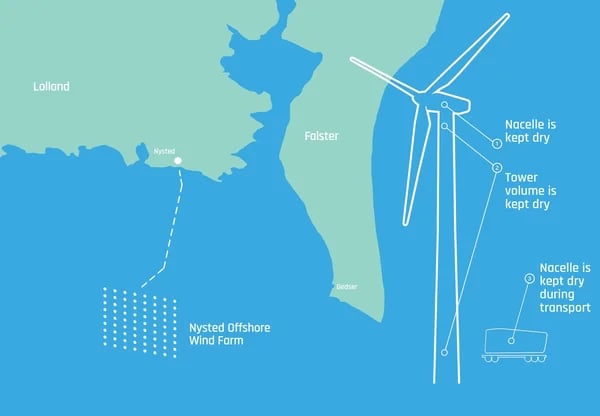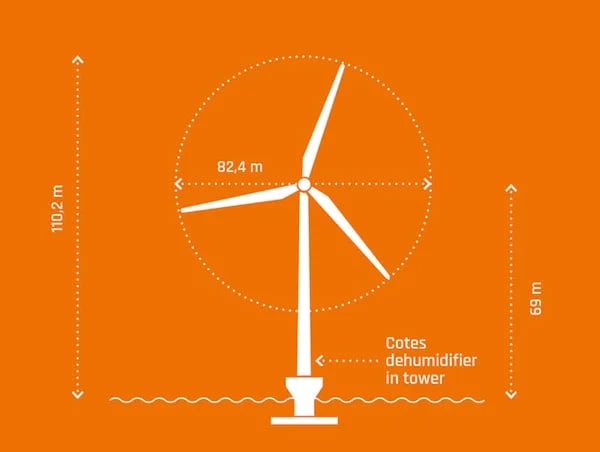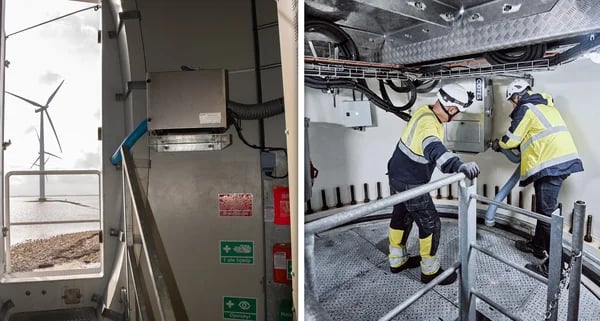They say, “only time will tell,” well, we recently checked in with the team at the Nysted offshore wind farm and time has spoken — controlling excess humidity and salt in your wind turbine does extend the lifespan of your turbine. Furthermore, you can increase your return on investment by reducing the cost of unplanned downtime caused by electrical wind generator failures, corrosion damage or mould contamination.
 Above image: A map of the southeastern coast of Denmark where the Nysted Wind Farm is located with an illustration showing the different areas where a Cotes dehumidifier can make a positive impact.
Above image: A map of the southeastern coast of Denmark where the Nysted Wind Farm is located with an illustration showing the different areas where a Cotes dehumidifier can make a positive impact.
Nysted Offshore Wind Farm [Rødsand]
The Nysted Offshore Wind Farm in Denmark was installed with Cotes adsorption dehumidifiers way back when the wind farm began commercial operations in December 2003. Originally operated by DONG Energy, now Ørsted, the Nysted wind farm is to this day in great shape and there is no doubt that our dry-air solution helped extend operational lifespan beyond original expectations and projections.
We revisited the case and spoke to someone with firsthand knowledge and experience of the operational wind turbine efficiency of the Nysted wind farm and asked how things were going. We did not get permission to use the person's name or title and for that reason, he/she will remain anonymous:
“When turbines are offshore, they are exposed to the elements and there is a considerable risk that you have air with lots of moisture circulating the turbine coming from the sea and from above. Therefore, the dehumidifier, in this case at the bottom and top of the turbine, helps keep the humidity low and reduces risks from corrosion. The turbines look like they are new, i.e., like they did 17 years ago.”
The Nysted Offshore Wind Farm lies about 10 km out to sea off the southeastern tip of Denmark and is exposed to the elements 24/7. It consists of eight rows of nine Siemens Wind Power 2.3 MW turbines and was one of the world’s largest wind farms at the time of construction.
Video above: We asked Peder Nickelsen, who has decades of experience in the wind industry and is seen as one of the pioneers and founding fathers of the modern wind industry, how to extend the wind turbine lifetime. For more than 25 years he worked at Siemens Wind Power. Nickelsen is now COO of Stiesdal Offshore Technologies, where they develop new foundation designs, storage and PtX solutions.
Preventing electrical faults, corrosion, and unplanned downtime in offshore turbines
If you don’t have an effective dry-air strategy for your wind turbines then the high levels of moisture in the sea air, often saturated with corrosive salts due to the offshore environment, can have detrimental effects on the structures, operating uptime and maintenance budgets, in this case, offshore wind turbines, but also in onshore and nearshore turbines. Insufficient prevention of these problems in a wind farm can, moreover, lead to turbine failures, expensive downtime and various other wind turbine maintenance issues. Read more on the likelihood of mould growth in offshore wind turbine towers.
DONG Energy, now Ørsted, was responsible for the operation and maintenance of the Nysted facility and had a special interest in the reliability and durability of these wind turbines. Sending technicians out by boat to undertake service and repairs is time-consuming, potentially dangerous, and always involves substantial downtime cost per hour. Some operators and utilities are trying to reduce maintenance costs by treating the symptom but to really solve the issues of humidity you need to address the cause of the issue, not the symptom.
The Nysted wind farm runs on Siemens turbines and through our long-standing partnership and cooperation with Siemens, Siemens understands the benefits of dry air which is why they installed two Cotes CR80B dehumidifiers in each of these 72 wind turbines, one unit in the tower and the other unit in the nacelle, supplementing standard Siemens corrosion protection measures. The purpose of Cotes dehumidifiers is to remove and reduce moisture from the flow of air around the turbine machinery, transformer unit, and from the electrical cabinets containing sensitive electrical and electronic equipment. Wind turbines are not designed to be air-tight so there is a constant flow of moisture through the turbine structure, the trick is to create an overpressure inside the structure or to focus and localize the dry air where it matters most for you.
 Image above: An illustration of the 2.3 MW Siemens wind turbine installed at Nysted Wind Farm fitted with a Cotes adsorption dehumidifier.
Image above: An illustration of the 2.3 MW Siemens wind turbine installed at Nysted Wind Farm fitted with a Cotes adsorption dehumidifier.
Finding the right dry-air strategy and solution for you
So how do you protect a wind turbine? What is your dry-air strategy? The basic laws of physics mean that corrosion in a wind turbine’s metal structures can only take place if both oxygen and moisture are present. The presence of salt in offshore and nearshore installations just serves as a catalyst. Using a Cotes adsorption dehumidifier removes the moisture from the air and filters out the salt, eliminating the possibility of both corrosion and condensation.
Low-maintenance cost and better reliability
How often do these wind turbines need maintenance and how long do these industrial dehumidifiers last? In 2014, the Nysted turbines had been in non-stop service (non-stop refers to unscheduled service stops) for 7 years and less than half of the dehumidifier units had ever shown faults. According to Jesper Nielsen, the DONG Energy manager responsible for maintenance of the Nysted wind turbines at the time stated, “They’re strongly built and service-friendly. They just keep on working as intended, and we rarely see anything wrong.” The only maintenance or repairs the Cotes dehumidifiers normally require is the changing of the filters once a year, in conjunction with the annual maintenance visit. If anything is wrong, technicians simply replace the whole dehumidifier with a spare and take the one needing attention back to the workshop on land. This helps keep maintenance costs to a bare minimum.
Better return on investment
How do you prolong a wind turbine’s lifetime? Well, in 2014, DONG Energy noted that the combination of low service and maintenance costs added up to a measurably better wind farm generator output and return on investment for them and it also extended the service lifespan for both the sensitive installations and the actual structures of the wind turbines in the Nysted facility.
“There’s no doubt that the Cotes dehumidifiers have proved to be a really good equipment choice. They’re straightforward and functional, and we can rely on them to get the job done and extend the service life of DONG Energy’s investment in this facility,” stated Jesper Nielsen, the manager responsible for maintenance of the Nysted wind turbines at the time.
Fast forward to 2021, and one source familiar with the project, and again we were not able to get permission to use the person's name or title, says:
“Originally, the turbines at Nysted offshore wind farm were planned to last for 20 years. In the context of extending operational lifetime, we have looked at the condition of the turbines and evaluated that 25 years is not even an ambitious goal today, we are looking at 30+ years of operational lifetime.”
Remove moisture from the air and protect your wind turbine from humidity

Image to left: Standard CR80 dehumidifier installation at the base of a 2.3 MW Siemens turbine tower.
Image to right: New generation CWO unit installed in the tower creates an overpressure and removes moisture and salt from the air inside the turbine.
Cotes’ dry-air solutions offer the proven technology of desiccant dehumidification for stabilising the ambient conditions inside wind turbines all year round, ensuring optimal humidity levels. Cotes’ industrial dehumidifiers control deviations in relative humidity and will minimise condensation and reduce the chances of electrical failures, unexpected downtime and unscheduled wind turbine maintenance issues.
Tell us about your humidity issue